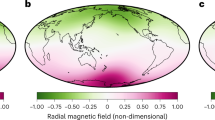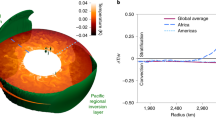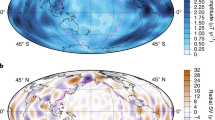Abstract
The Earth can be viewed as a massive heat engine, with various energy sources and sinks. Insights into its evolution can be obtained by quantifying the various energy contributions in the context of the overall energy budget. Over the past decade, estimates of the heat flow across the core–mantle boundary, or across a chemical boundary layer above it, have generally increased by a factor of 2 to 3. The current total heat flow at the Earth's surface — 46 ± 3 terawatts (1012 J s−1) — involves contributions from heat entering the mantle from the core, as well as mantle cooling, radiogenic heating of the mantle from the decay of radioactive elements, and various minor processes such as tidal deformation, chemical segregation and thermal contraction gravitational heating. The increased estimates of deep-mantle heat flow indicate a more prominent role for thermal plumes in mantle dynamics, more extensive partial melting of the lowermost mantle in the past, and a more rapidly growing and younger inner core and/or presence of significant radiogenic material in the outer core or lowermost mantle as compared with previous estimates.
This is a preview of subscription content, access via your institution
Access options
Subscribe to this journal
Receive 12 print issues and online access
$259.00 per year
only $21.58 per issue
Buy this article
- Purchase on Springer Link
- Instant access to full article PDF
Prices may be subject to local taxes which are calculated during checkout





Similar content being viewed by others
References
Pollack, H. N., Hurter, S. J. & Johnson, J. R. Heat flow from the Earth's interior: analysis of the global data set. Rev. Geophys. 31, 267–280 (1993).
Jaupart, C., Labrosse, S. & Mareschal, J.-C. Temperatures, heat and energy in the mantle of the Earth. Treatise on Geophys. (in the press).
Kellogg, L. H., Hager, B. H. & van der Hilst, R. D. Compositional stratification in the deep mantle. Science 283, 1881–1884 (1999).
Nolet, G., Karato, S.-I. & Montelli, R. Plume fluxes from seismic tomography. Earth Planet. Sci. Lett. 248, 685–699 (2006).
Stacey, F. D. & Loper, D. E. The thermal boundary layer interpretation of D″ and its role as a plume source. Phys. Earth Planet Inter. 33, 45–55 (1983).
Davies, G. F. Ocean bathymetry and mantle convection. 1. Large-scale flow and hotspots. J. Geophys. Res. 93, 10467–10480 (1988).
Sleep, N. H. Hotspots and mantle plumes: some phenomenology. J. Geophys. Res. 95, 6715–6736 (1990).
Williams, Q. in The Core-Mantle Boundary Region (eds Gurnis, M., Wysession, M. E., Knittle, E. & Buffett, B. A.) 73–81 (AGU, Washington DC, 1998).
Holland, K. G. & Ahrens, T. J. Melting of (Mg,Fe)2SiO4 at the core-mantle boundary of the Earth. Science 275, 1623–1625 (1997).
Boehler, R. High-pressure experiments and the phase diagram of lower mantle and core materials. Rev. Geophys. 38, 221–245 (2000).
Akins, J. A., Luo, S.-N., Asimow, P. D. & Ahrens, T. J. Shock-induced melting of MgSiO3 perovskite and implications for melts in Earth's lowermost mantle. Geophys. Res. Lett. 31, L14612 (2004).
Ahrens, T. J., Holland, K. G. & Chen G. Q. Phase diagram of iron, revised-core temperatures. Geophys. Res. Lett. 29, 1150 (2002).
Anderson, O. L. The power balance at the core-mantle boundary. Phys. Earth Planet. Inter. 131, 1–17 (2002).
Stacey, F. D. Physics of the Earth. 3rd edn (Brookfield Press, Brisbane, Australia, 1992).
Buffett, B. A. The thermal state of Earth's core. Science 299, 1675–1676 (2003).
Alfe, D. Gillan, M. J. & Price, G. D. Thermodynamics from first principles: temperature and composition of the Earth's core. Min. Mag. 67, 113–123 (2003).
Nimmo, F. Core Dynamics: Energetics of the core, in Treatise on Geophys. (in the press).
Hofmeister, A. M. Mantle values of thermal conductivity and the geotherm from phonon lifetimes. Science 283, 1699–1706 (1999).
Stacey, F. D. & Loper, D. E. A revised estimate of the conductivity of iron alloy at high pressure and implications for the core energy balance. Phys. Earth Planet. Inter. 161, 13–18 (2007).
Goncharov, A. F., Struzhkin, V. V. & Jacobsen, S. D. Reduced radiative conductivity of low-spin (Mg,Fe)O in the lower mantle. Science 312, 1205–1208 (2006).
Lay, T., Williams, Q. & Garnero, E. J. The core-mantle boundary layer and deep Earth dynamics. Nature 392, 461–468 (1998).
Wang, Y. & Wen, L. Geometry and P and S velocity structure of the “African Anomaly”. J. Geophys. Res. 112, B05313 (2007).
Simmons, N. A., Forte, A. M. & Grand, S. P. Thermochemical structure and dynamics of the African superplume. Geophys. Res. Lett. 34, L02301 (2007).
Farnetani, C. G. Excess temperature of mantle plumes: the role of chemical stratification across D″. Geophys. Res. Lett. 24, 1583–1586 (1997).
Tackley, P. J. Mantle convection and plate tectonics: toward an integrated physical and chemical theory. Science 288, 2002–2007 (2000).
Montague, N. L. & Kellogg, L. H. Numerical models of a dense layer at the base of the mantle and implications for the geodynamics of D″. J. Geophys. Res. 105, 11101–11114 (2000).
Zhong, S. & Hager, B. H. Entrainment of a dense layer by thermal plumes. Geophys. J. Int. 154, 666–676 (2003).
McNamara, A. K. & Zhong, S. Thermochemical structures beneath Africa and the Pacific Ocean. Nature 437, 1136–1139 (2005).
Namiki, A. & Kurita, K. Heat transfer and interfacial temperature of two-layered convection: Implications for the D″-mantle coupling. Geophys. Res. Lett. 30, 1023 (2003).
Stacey, F. D. & Anderson, O. Electrical and thermal conductivities of Fe-Ni-Si alloy under core conditions. Phys. Earth Planet. Inter. 124, 153–162 (2001).
Buffett, B. A. Estimates of heat flow in the deep mantle based on the power requirements for the geodynamo. Geophys. Res. Lett. 29, 1555 (2002).
Christensen, U. & Tilgner, A. Power requirements of the geodynamo from Ohmic losses in numerical and laboratory dynamos. Nature 429, 169–171 (2004).
Glatzmaier, G. & Roberts, P. H. A three-dimensional self-consistent computer simulation of a geomagnetic field reversal. Nature 377, 203–209 (1995).
Gubbins, D., Alfe, D., Masters, G., Price, D. & Gillan, M. Gross thermodynamics of 2-component core convection. Geophys. J. Int. 157, 1407–1414 (2004).
Nakagawa, T. & Tackley, P. J. Deep mantle heat flow and thermal evolution of the Earth's core in thermochemical multiphase models of mantle convection. Geochem. Geophys. Geosyst. 6, Q08003 (2005).
Korenaga, J. Firm mantle plumes and the nature of the core-mantle boundary region. Earth Planet. Sci. Lett. 232, 29–37 (2005).
Davies, G. F. Mantle regulation of core cooling: A geodynamo without core radioactivity? Phys. Earth Planet. Inter. 160, 215–229 (2007).
Nimmo, F., Price, G. D., Brodholt, J. & Gubbins, D. The influence of potassium on core and geodynamo evolution. Geophys. J. Int. 156, 363–376 (2004).
Lister, J. R. & Buffett, B. A. Stratification of the outer core at the core-mantle boundary. Phys. Earth Planet. Int. 105, 5–19 (1998).
Helffrich, G. & Kaneshima, S. Seismological constraints on core composition from Fe-O-S liquid immiscibility. Science 306, 2239–2242 (2004).
Eaton, D. W. & Kendall, J.-M. Improving seismic resolution of outermost core structure by multichannel analysis and deconvolution of broadband SmKS phases. Phys. Earth Planet. Inter. 155, 104–119 (2006).
Tanaka, S. Seismic detectability of anomalous structure at the top of the Earth's outer core with broadband array analysis of SmKS phases. Phys. Earth Planet. Int. 141, 141–152 (2004).
Gubbins, D. Geomagnetic constraints on stratification at the top of Earth's core. Earth Planets Space 59, 661–664 (2007).
Davies, G. F. Cooling the core and mantle by plume and plate flows. Geophys. J. Int. 115, 132–146 (1993).
Mittelstaedt, E. & Tackley, P. Plume heat flow is much lower than cmb heat flow. Earth Planet. Sci. Lett. 241, 202–210 (2006).
Labrosse, S. Hotspots, mantle plumes and core heat loss. Earth Planet. Sci. Lett. 199, 147–156 (2002).
Behn, M., Conrad, C. & Silver, P. Detection of upper mantle flow associated with the African superplume. Earth Planet. Sci. Lett. 224, 259–274 (2004).
Zhong, S. Constraints on thermochemical convection of the mantle from plume heat flux, plume excess temperature, and upper mantle temperature. J. Geophys. Res. 111, B04409 (2006).
Jellinek, A. M. & Manga, M. The influence of a chemical boundary layer on the fixity, spacing and lifetime of mantle plumes. Nature 418, 760763 (2002).
Nakagawa, T. & Tackley, P. J. Effects of thermo-chemical mantle convection on the thermal evolution of the Earth's core. Earth Planet Sci. Lett. 220, 107–119 (2004).
Tan, E. & Gurnis, M. Compressible thermochemical convection and application to lower mantle structures. J. Geophys. Res. 112, B06304 (2007).
Nataf, H.-C. Seismic imaging of mantle plumes. Annu. Rev. Earth Planet. Sci. 28, 319–417 (2000).
Goes, S. Cammarano, F. & Hansen, U. Synthetic seismic signature of thermal plumes. Earth Planet. Sci. Lett. 218, 403–419 (2004).
Zhao, D. Seismic structure of hotspots and mantle plumes. Earth and Planet. Sci. Lett. 192, 251–265 (2001).
Montelli, R., Nolet, G., Dahlen, F. A., Masters, G. Engdahl, E. R. & Hung, S.-H. Finite-frequency tomography reveals a variety of plumes in the mantle. Science 303, 338–343 (2004).
Thorne, M. S., Garnero, E. J. & Grand, S. P. Geographic correlation between hotspots and deep mantle lateral shear-wave velocity gradients. Phys. Earth Planet. Inter. 146, 47–63 (2004).
Romanowicz, B. & Gung, Y. C. Superplumes from the core-mantle boundary to the lithosphere: implications for heat flux. Science 296, 513–516 (2002).
Murakami, M., Hirose, K., Kawamura, K. Sato, N & Ohishi, Y. Post-perovskite phase transition in MgSiO3 . Science 304, 855–858 (2004).
Oganov, A. R. & Ono, S. Theoretical and experimental evidence for a post-perovskite phase of MgSiO3 in Earth's D″ layer. Nature 430, 445–448 (2004).
Hirose, K. Postperovskite phase transition and its geophysical implications. Rev. Geophys. 44, RG3001 (2006).
Stackhouse, S., Brodholt, J. P., Wookey, J., Kendall, J.-M. & Price, G. D. The effect of temperature on the seismic anisotropy of the perovskite and post-perovskite polymorphs of MgSiO3 . Earth Planet. Sci. Lett. 230, 1–10 (2005).
Wentzcovitch, R. M., Tsuchiya, T. & Tsuchiya, J. MgSiO3 postperovskite at D″ conditions. Proc. Nat. Acad. Sci. USA 103, 543–546 (2006).
Wookey, J., Stackhouse, S., Kendall, J.-M., Brodholt, J. & Price, G. D. Efficacy of post-perovskite as an explanation for lowermost mantle seismic properties. Nature 438, 1004–1007 (2005).
Wysession, M. E. et al. in The Core-Mantle Boundary Region. (eds Gurnis, M., Wysession, M. E., Knittle, E. & Buffett, B. A.) 273–297 (AGU, Washington DC, 1998).
Lay, T. & Garnero, E. J. in Post-perovskite: The Last Phase Change. (eds Hirose, K., Brodholt, J., Lay, T. & Yuen D.) (AGU, in the press).
Sidorin, I., Gurnis, M. & Helmberger, D. V. Evidence for a ubiquitous seismic discontinuity at the base of the mantle. Science 286, 1326–1331 (1999).
Spera, F. J., Yuen, D. A. & Giles, G. Tradeoffs in chemical and thermal variations in the post-perovskite phase transition: Mixed phase regions in the deep lower mantle? Phys. Earth Planet. Inter. 159, 234–246 (2006).
Hirose, K. Sinmyo, R., Sata, N. & Ohishi, Y. Determination of post-perovskite phase transition boundary in MgSiO3 using Au and MgO pressure standards. Geophys. Res. Lett. 33, L01310 (2006).
Helmberger, D. V., Lay, T., Ni, S. & Gurnis, M. Deep mantle structure and the post-perovskite phase transition. Proc. Natl Acad. Sci. USA 102, 17257–17263 (2005).
Chambers, K. & Woodhouse, J. H. Transient D″ discontinuity revealed by seismic migration. Geophys. Res. Lett. 33, L17312 (2006).
Lay, T., Hernlund, J., Garnero, E. J. & Thorne, M. S. A post-perovskite lens and D″ heat flux beneath the central Pacific. Science 314, 1272–1276 (2006).
Sun, D., Song, T.-R. A. & Helmberger, D. Complexity of D″ in the presence of slab-debris and phase changes. Geophys. Res. Lett. 33, L12S07 (2006).
Sun, D. Tan, E., Helmberger, D. & Gurnis, M. Seismological support for the metastable superplume model, sharp features, and phase changes within the lower mantle, Proc. Natl Acad. Sci. USA 104, 9151–9155 (2007).
van der Hilst, R. D., de Hoop, M. V., Wang, P., Shim, S.-H., Ma, P. & Tenorio, L. Seismostratigraphy and thermal structure of Earth's core-mantle boundary region. Science 315, 1813–1817 (2007).
Braginski, S. I. & Roberts, P. H. Equations governing convection in Earth's core and the geodynamo. Geophys. Astrophys. Fluid Dyn. 79, 1–97 (1995).
Hernlund, J. W., Thomas, C. & Tackley, P. J. A doubling of the post-perovskite phase boundary and structure of the Earth's lowermost mantle. Nature 434, 882–886 (2005).
Kaus, B. J. P., Connolly, J. A. D., Podladchikov, Y. Y. & Schmalholz, S. M. The effect of mineral phase transitions on sedimentary basic subsidence and uplift. Earth Planet. Sci. Lett. 233, 213–228 (2005).
Thomas, C., Garnero, E. J. & Lay, T. High-resolution imaging of lowermost mantle structure under the Cocos plate. J. Geophys. Res. 109, B08307 (2004).
Thomas, C., Kendall, J.-M. & Lowman, J. Lower-mantle seismic discontinuities and the thermal morphology of subducted slabs. Earth Planet. Sci. Lett. 225, 105–113 (2004).
Flores, C. & Lay, T. The trouble with seeing double. Geophys. Res. Lett. 32, L24305 (2005).
Avants, M. Lay, T., Russell, S. A. & Garnero, E. J. Shear velocity variation within the D″ region beneath the central Pacific. J. Geophys. Res. 111, B05305 (2006).
Buffett, B. A. Bounds on heat flow beneath a double crossing of the perovskite-postperovskite phase transition. Geophys. Res. Lett. (submitted).
Hernlund, J. W. & Labrosse, S. Geophysically consistent values of the perovskite to post-perovskite transition Clapeyron slope. Geophys. Res. Lett. 34, L05309 (2007).
Garnero, E. J., Revenaugh, J., Williams, Q., Lay, T. & Kellogg, L. H. in The Core-Mantle Boundary Region (eds Gurnis, M., Wysession, M. E., Knittle, E. & Buffett, B. A.) 319–334 (AGU, Washington DC, 1998).
Williams, Q. & Garnero E. J. Seismic evidence for partial melt at the base of the Earth's mantle. Science 273, 1528–1530 (1996).
Knittle, E. & Jeanloz, R. The Earth's core–mantle boundary: results of experiments at high pressures and temperatures. Science 251, 1438–1443 (1991).
Kanda, R. V. S. & Stevenson, D. J. Suction mechanism for iron entrainment into the lower mantle. Geophys. Res. Lett. 33, L02310 (2006).
Dobson, D. P. & Brodholt, J. P. Subducted banded iron formations as a source of ultralow-velocity zones at the core-mantle boundary. Nature 434, 371–373 (2005).
Buffett, B. A., Garnero, E. J. & Jeanloz, R. Sediments at the top of Earth's core. Science 290, 1338–1342 (2000).
Mao, W. L. et al. Iron-rich post-perovskite and the origin of ultralow-velocity zones. Science 312, 564–565 (2006).
Labrosse, S., Hernlund, J. W. & Coltice, N. A crystallising dense magma ocean at the base of the Earth's mantle. Nature (in the press).
Thorne, M. S. & Garnero, E. J. Inferences on ultra-low velocity zone structure from a global analysis of SPdKS waves. J. Geophys. Res. 109, B08301 (2004).
Rost, S., Garnero, E. J., Williams, Q. & Manga, M. Seismic constraints on a possible plume root at the core-mantle boundary. Nature 435, 666–669 (2005).
Hernlund, J. & Tackley, Some dynamical consequences of partial melting in Earth's deep mantle. Phys. Earth Planet. Inter. (in the press).
Stixrude, L. & Karki, B. Structure and freezing of MgSi03 liquid in Earth's lower mantle. Science 310, 297–299 (2005).
Boyet, M. & Carlson, R. 142Nd evidence for early (> 4.53 Ga) global differentiation of the silicate Earth. Science 309, 576–581 (2005).
Labrosse, S., Poirier, J.-P. & Le Mouel, J.-L. The age of the inner core. Earth Planet. Sci. Lett. 190, 111–123 (2001).
Conrad, C. P. & Hager, B. H. Thermal evolution of an Earth with strong subduction zones. Geophys. Res. Lett. 26, 3041–3044 (1999).
Korenaga, J., Energetics of mantle convection and the fate of fossil heat. Geophys. Res. Lett. 30, 1437 (2003).
Labrosse, S. & Jaupart, C. The thermal evolution of the Earth: Long term and fluctuations. Earth Planet. Sci. Lett. (in the press).
Acknowledgements
We thank F. Nimmo and S. Labrosse for preprints, and F. Nimmo, Richard Holme and Bill McDonough for their comments on the manuscript. T.L.'s research on the deep Earth is supported by the NSF.
Author information
Authors and Affiliations
Contributions
T.L., J.H. and B.A.B. contributed equally to the writing, data analysis and ideas in this paper.
Corresponding author
Rights and permissions
About this article
Cite this article
Lay, T., Hernlund, J. & Buffett, B. Core–mantle boundary heat flow. Nature Geosci 1, 25–32 (2008). https://doi.org/10.1038/ngeo.2007.44
Issue Date:
DOI: https://doi.org/10.1038/ngeo.2007.44
This article is cited by
-
The Lithospheric Thermal Structure in the Songliao Basin Inferred from Thermal Parameter Analyses: Implications for the Background of Geothermal Resources
Natural Resources Research (2024)
-
Development of hierarchical sub-surface energy anomaly index and its significance on seismic hazard study through geoinformatics in Lower Tista sub-basin, India
Arabian Journal of Geosciences (2024)
-
Hydrochemical stratigraphic analysis of the filling of the Meirama mine shaft I: monitoring and filling
Environmental Earth Sciences (2024)
-
Links between large igneous province volcanism and subducted iron formations
Nature Geoscience (2023)
-
Effects of depth- and composition-dependent thermal conductivity and the compositional viscosity ratio on the long-term evolution of large thermochemical piles of primordial material in the lower mantle of the Earth: Insights from 2-D numerical modeling
Science China Earth Sciences (2023)



